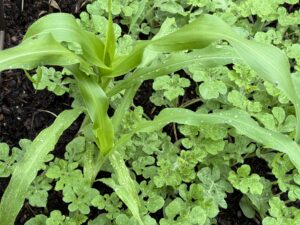Companion planting for fruits and vegetables

Kitchen Vegan Chronicles As spring is in full bloom, the season of planting and growing should be fresh on the mind. For small spaces and a bountiful harvest with a variety of fruits and vegetables, the technique of companion planting should be considered.
Companion planting is the practice of growing plants together in a community so that each plant benefits from the presence of the other and thrives. As such, members of a plant community that are known to support each other typically produce more fruits and vegetables that are noticeably more resilient and productive. This is so because companion planting tends to attract pollinators, minimize pest infestation and damage, reduce weed competition and boost soil fertility. Additionally, gardens cultivated with companion planting in mind tend to look fuller and are healthier, due to lush vegetation. Let’s explore a few reasons why this technique will elevate your gardening experience.
Pest infestation is one of the biggest challenges for the everyday gardener. The use of pesticides and insecticides is one potential fix. However, they may have unintended consequences such as warding off and killing beneficial bugs and insects in the process. Co-planting basil with tomatoes or peppers, for example, helps deter the moths that lay hornworms and armyworms from the plants. The same is true for co-planting carrots with sage. Sage repels carrot flies, ensuring a bountiful carrot harvest.

Co-planting is also a space saving technique designed to regulate shade, such that short-season crops can be planted with later maturing crops, resulting in the conservation of space, the provision of shade for smaller plants and the growth of multiple successions of plants during the growing season. Plants that will benefit from companion planting to save space include lettuce, spinach or basil paired with peppers, tomatoes, or corn.
As mentioned earlier, companion planting also promotes soil health by improving soil fertility. The planting of vegetation with different root systems results in optimal soil aeration and the availability of the most suitable nutrients for each plant. Taproot vegetables such as carrots and tubers such as potatoes can help to break up compact soil. They also pull nutrients from deep in the soil, enriching the topsoil. Deep rooted vegetables such as melon, cucumber and tomatoes also pull water and nutrients from the deepest portion of the soil, making the topsoil rich for shallow root plants and eliminating competition for nutrients. Co-planting with legumes also has the benefit of maximizing soil health since legumes fix or provide a certain amount of nitrogen taken from the atmosphere to the soil reducing the need for additional fertilizer. This is also why legumes make excellent cover crops.

Companion planting also promotes plant support. For this scenario, plants in the community physically support each other, reducing the need for external support from the use of stalks and trellis. Co-planting corn or sunflowers with beans, peas or cucumbers for example results in a symbiotic relationship where the corn or sunflower renders physical support by providing a stalk for the beans or cucumber to climb. The beans in turn provide nitrogen to the corn. Cucumbers in this case serve to attract pollinators to the taller plants.
Finally, companion planting can serve as a means of weed suppression. So, planting sprawling crops such as potatoes minimizes the availability of open areas, where weeds would typically pop up. Weeds can be detrimental to a garden as these plants often grow quickly and compete for water and nutrients in the soil. Co-planting also enhances the beauty of your garden and increases the lush factor.
As you plan your vegetable garden for the season, be sure to keep in mind the benefits of companion gardening which is certain to produce a bountiful harvest boasting a large spread of fruits and veggies. Happy gardening!
Dr. Jerainne Johnson-Heywood is a Physical Chemist, home chef, culinary influencer, and a food enthusiast, focused on creating plant-based cuisines! Her culinary brand is The Uncomplicated Palate.






